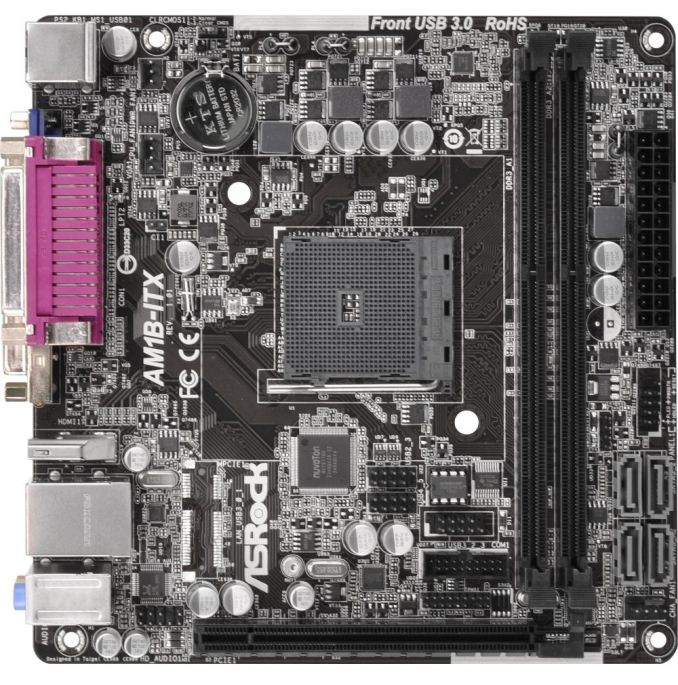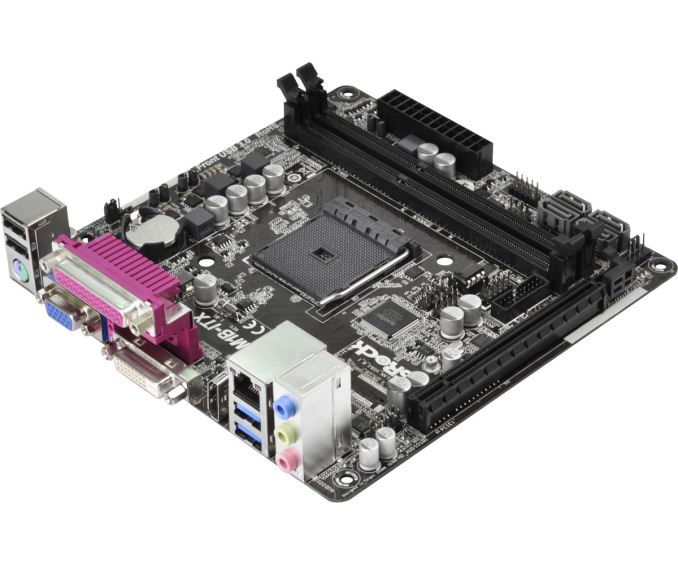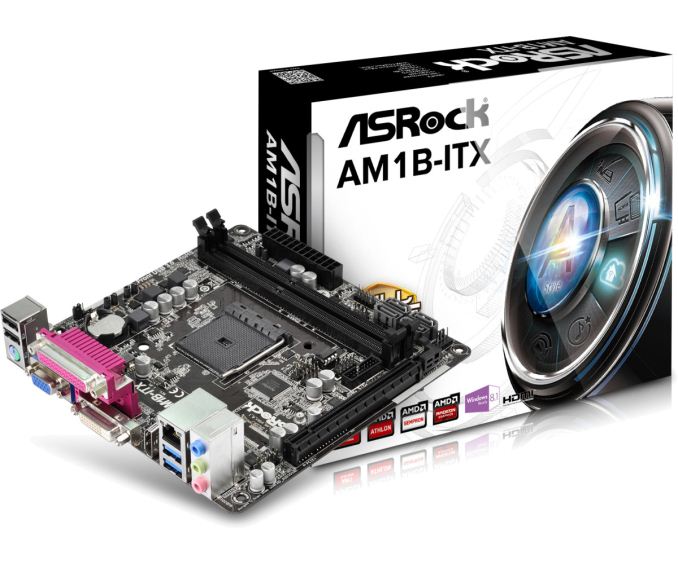The AM1 Kabini Motherboard Preview: Analyzing the Hardware
by Ian Cutress on April 19, 2014 2:00 PM ESTASRock AM1B-ITX
Moving to $40 and above brings a raft of changes – even by moving up a dollar does the AM1 landscape seem to change rapidly enough. To coin the eponymous phrase, ‘And now for something completely different’. The AM1B-ITX does what a motherboard above the base should do: add functionality and reduce complexity. Here we get double the SATA 6 Gbps ports and double the USB 3.0 ports, as well as three fan headers and an integrated parallel port on the rear panel whilst at the same time removing the need of a 4-pin CPU power connector.
ASRock has placed the 24-pin ATX connector, the four SATA 6 Gbps ports and the front panel header outside the DRAM slots (to the right), making cable management with this mini-ITX motherboard a lot easier. The SATA ports are also alternate facing to aid removal of locking SATA cables. Just inside the DRAM slots at the bottom are some of the additional headers – the COM header, the TPM header, the USB 3.0 header and two USB 2.0 headers. It might actually be a little too cramped in there.
Despite removing 4-pin CPU power connector, the top of the motherboard does look extremely busy with all the components on board. Two of the fan headers are in this area at the top left, while the third is at the bottom right. As with the other motherboards in this preview, the main PCIe 2.0 x16 slot runs at x4 mode due to the PCIe lane allocation, and of the lanes that are left ASRock has diverted one each to ASMedia controllers for the extra USB 3.0 and SATA 6 Gbps ports respectively.
While we lose the two extra USB 2.0 ports from the AM1B-M on the previous page, the rear panel gets access to more video outputs and a parallel port instead. When an antiquated port is added to a modern product, some users will bemoan its presence. More often than not, these are added because companies that use old equipment that communicates via the parallel port can cost six figures and is only updated once every few decades, so it is easier to update a $400 PC than a $400000 milling machine.
| ASRock AM1B-ITX | |
| Price | Link |
| Size | Mini-ITX |
| CPU Interface | FS1b |
| Chipset | Kabini |
| Memory Slots |
Two DDR3 DRAM slots, supporting 16 GB Single Channel, 1066-1600 MHz |
| Video Outputs |
VGA (2048x1536 at 60 Hz) DVI-D (1920x1200 at 60 Hz) HDMI (4096x2160 at 24 Hz or 3840x2160 at 30Hz) |
| Onboard LAN | Realtek RTL8111GR |
| Onboard Audio | Realtek ALC662 |
| Expansion Slots | PCIe 2.0 x16 (x4) |
| Onboard SATA/RAID |
2 x SATA 6 Gbps (Chipset) 2 x SATA 6 Gbps (ASMedia ASM1061) |
| USB 3.0 |
2 x USB 3.0 (Chipset) [back panel] 2 x USB 3.0 (ASMedia ASM1042A) [header] |
| Onboard |
4 x SATA 6 Gbps 1 x USB 3.0 Header 2 x USB 2.0 Headers 3 x Fan Headers 1 x COM Header 1 x TPM Header Front Audio Header Front Panel Header |
| Power Connectors | 1 x 24-pin ATX |
| Fan Headers |
1 x CPU (4-pin) 1 x CHA (4-pin) 1 x PWR (3-pin) |
| IO Panel |
1 x PS/2 Combination Port 1 x Parallel Port VGA DVI-D HDMI 2 x USB 2.0 2 x USB 3,0 1 x Gigabit Ethernet Audio Jacks (ALC662) |
| Product Page | Link |
Price wise, the ASRock AM1B-ITX blows the AM1B-M out of the water. For a few extra dollars there are more ports for more of the things most users will want. There is still the issue of that bottom-of-the-barrel Realtek ALC662 though.














64 Comments
View All Comments
JFish222 - Monday, April 21, 2014 - link
I agree, its disappointing that there is no ECC. (At least not listed.)I was really looking forward to using one of these for a low cost FreeNAS box.
Ian, Anand and company. Please encourage ECC bios support/validation! If any of the manufacturers support it (not always obvious when they do) please point it out.
For those that don't understand the importance, ZFS has numerous benefits but its greatest weakness is the ability to corrupt the entire data pool due to a flipped bit or 2 in RAM.
For more info - http://forums.freenas.org/index.php?threads/ecc-vs...
Chicken76 - Monday, April 21, 2014 - link
Indeed, Anandtech has the ear of motherboard manufacturers. They might respond positively if such suggestions are properly argumented. There's not only the enthusiast home user that these might be useful to, there's also the small businesses sector, where cost is a deciding factor. Add ECC support and a bit of validation for production use, and a lot of the cost-conscientious businesses will refresh their storage boxes and low workload machines using Kabini, instead of the Pentiums and Celerons they use now.rogueninja - Sunday, April 20, 2014 - link
Only bad friends recommend AMD.meacupla - Sunday, April 20, 2014 - link
Currently, AMD's most attractive CPU parts are the $60 A6-6400k and $120 FX-6300.Pentium and i3 have more single thread computing power, but looking at the entire package, AMD has some advantages at those price points.
Like a cheap 8 port SATA mobo, you can't have that with cheap LGA1150 boards.
or having 6 physical cores.
Antronman - Monday, April 21, 2014 - link
Except that when you're on a low budget, AMD is the only thing you should be recommending.Ortanon - Tuesday, April 22, 2014 - link
Intel usually wins low-budget too, haha. If you're talking "best gaming performance at the absolute bottom," yes, AMD wins. But who wants to game down there? As soon as you try to add any performance to your build whatsoever, it turns into an Intel solution with a PCIe GPU. It's possible that this would be different if all software was highly-threaded, but it just doesn't work out that way.AlB80 - Sunday, April 20, 2014 - link
Gigabyte's mobo has heatsink. What behind it? SuperIO?DuckieHo - Monday, April 21, 2014 - link
Biostar's mITX-Plus..... isn't that just AMD's DTX form factor?JBVertexx - Monday, April 21, 2014 - link
Stumbled across this - PC build in the motherboard box:https://www.youtube.com/watch?v=xngzjrKg3zI
WeatherDave - Monday, April 21, 2014 - link
"COM port, LPT port and a TPM port on the same PCB"We have about 50 machines here. Mostly for embedded testing, such as stepper motors, and old equipment that ONLY connects via Serial Port. USB converters are both unreliable and prone to failure, so we like having the COM ports on board. Besides, Windows 98/2000 and XP much prefer them over a converter. Now, we don't have much use for the LPT, but TPM and a cheap SSD certainly keeps IT Security off our backs.